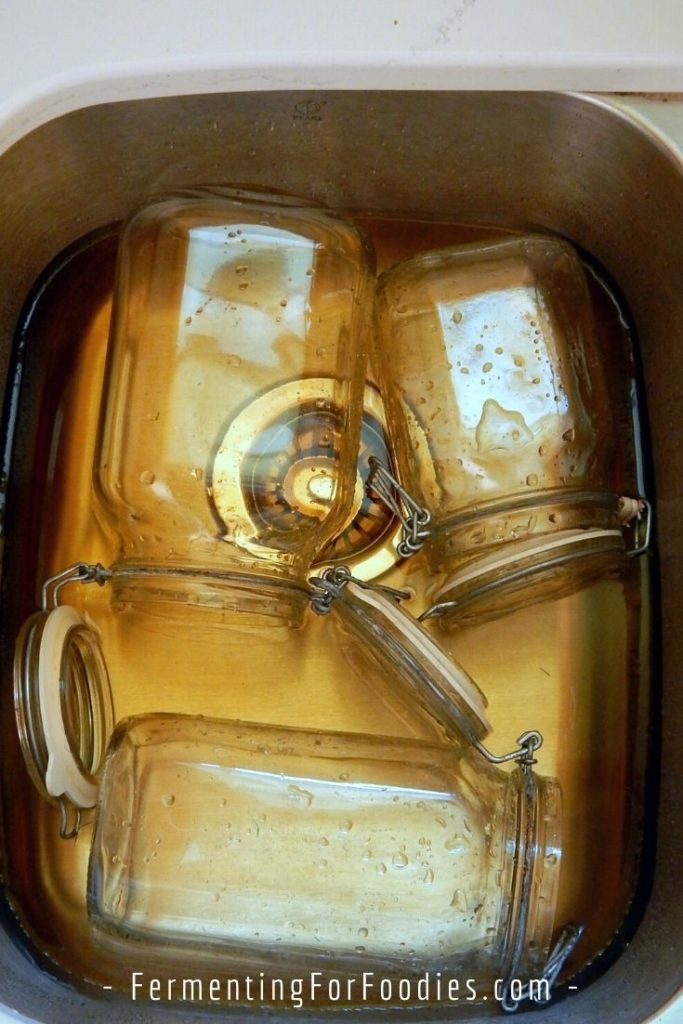Sanitation is an important first step for ALL types of fermentation. However, it’s particularly for anything that ferments for more than a few weeks, like cheese, miso, and alcohol. Here’s everything you need to know about cleaning for fermentation.

Sanitation versus Sterilization
–> Sanitation is when you clean something really well. It removes the surface bacteria and fungus, but not necessarily everything. Sanitation is good enough for all homemade ferments.
–> Sterilization is when every single bacteria, virus, or fungus is killed. While that seems ideal, it isn’t really reasonable for home or commercial kitchens. Usually, sterilization is only used for health care equipment.
When do you need to Sanitize Jars and Equipment?
Sanitization of jars and equipment isn’t always necessary. Personally, I don’t bother for most of my everyday ferments. This includes things like sourdough, milk kefir, yogurt, and quick snacking vegetables.
Here’s when you need to sanitize:
- It is always necessary for making hard cheese, beer, and wine.
- Whenever the ferment is going to be stored for more than a few weeks. Eg. fermented pickles that you’re going to eat in a few months time, sauerkraut, or apple cider vinegar.
- If you have issues with mold in the walls or ceiling of your home, you will need to sanitize for anything that is going to ferment for more than a few days to prevent contamination. Surface mold around windows and in the bathroom isn’t as problematic as pervasive mold.
- If a ferment was contaminated by mold or kahm yeast, then you will need to sanitize the contaminated containers.
How to sanitize for fermentation:
Here are the basic steps to sanitizing for fermentation.
- Pull your hair back so that it is out of the way.
- Wash your hands and sing “baa, baa black sheep” under running water, before touching anything to do with food preparation.
- Wipe down your counters with a sanitation solution.
- Sanitize all of the jars and equipment that you are going to use.
Methods of Sanitizing
There are several different ways of sanitizing equipment. I do a mix of boiling water and commercial sanitizers, depending on what I’m making.
Here are some specific details about each method.
1. Boiling Water
I use boiling water to sanitize my jars for pickles, sauerkraut, and vinegar.
There are two options:
- Fill a large pot up with water and bring it to a boil. Boil all of your glass and metal implements for 5 minutes. This is best if you’re making a large batch of fermented foods.
- If you’re just making a single jar of pickles, then fill the jar with boiling water, put on the lid, and leave it to sit for five minutes.
- Don’t use boiling water to sanitize plastic or wooden items.
2. Commercial Sanitizers
I typically use commercial sanitizers for beer, wine, cheese, etc. I fill my kitchen sink with the sanitizer mix and leave it there for the entire time I’m in the kitchen. That way if I accidentally drop something, I can easily sanitize it again.
I also wash and sanitize my equipment after using it. That way my auto-siphon or cheese mold is stored perfectly clean. It reduces the risk of contamination in the future.
There are many different types of commercial sanitizers available. I have used chlorine sanitizer powder and iodophor sanitizer. Both work equally well. Just follow the instructions on the package and rinse prior to use because sanitizers will also kill the yeast and bacteria that you want in your ferment.
3. Bleach
I have not personally used bleach. However, it is a common household sanitizer and is basically the same as chlorine sanitizer.
- Mix a solution of 2 Tbsp of bleach per gallon of water.
- Dip each piece of equipment in the bleach solution.
- Then rinse well prior to use.
- Bleach can also be used for spraying down surfaces.

When you boil a jar, do I need to line the pot with a grill or something to keep the jar from touching the bottom, or is it okay for it to just bounce around like a boiled egg? Thank you!
Great question! I have a canner with a jar rack for large amounts of processing. When I’m doing just a few jars, I put a washcloth on the bottom of the pot to stop them from potentially breaking. However, for sauerkraut and other vegetables, I usually just put my jars in the kitchen sink and fill them with boiling water, and put the lid on. Then I pour the water out 5 minutes later (wearing silicon oven mitts so I don’t get burned.) Cheers, Emillie
I’m just wondering if there’s any residual bleach left in the jar could prevent the fermentation from starting?
Yes… however, bleach evaporates fairly quickly. So if you let the jars air dry the bleach should just evaporate. I will admit to having this happen once when I was making wine! I learned to be a bit more patient with my sanitizing. 🙂